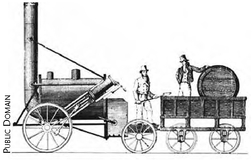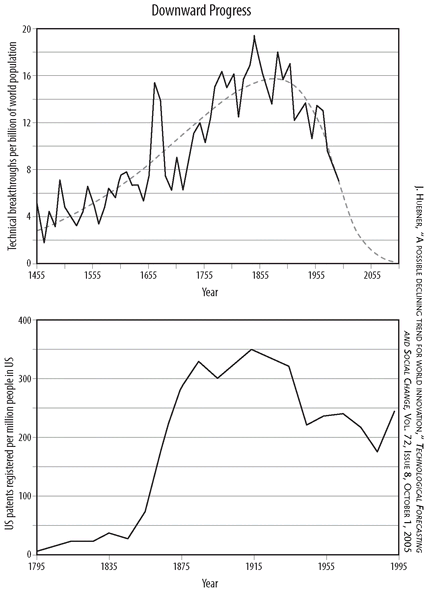1
Tools with a Life of Their Own
NEARLY EVERYONE complains from time to time that our tools have become Sorcerer’s Apprentices; that we have come to serve our machines instead of the other way around; and that, increasingly, our lives are regimented as if we ourselves were mere cogs in a vast mechanism utterly beyond our control.
We are not the first people to feel this way: criticism of technology has a history. The Luddites of early 19th-century England were among the first to raise their voices — and hammers! — against the dehumanizing side effects of mechanization. As industrialization proceeded decade-by-decade — from powered looms to steam shovels, jet planes, and electric toothbrushes — objections to the accelerating, mindless adoption of new technologies waxed erudite. During the past century, books by Lewis Mumford, Jacques Ellul, Ivan Illich, Kirkpatrick Sale, Stephanie Mills, Chellis Glendinning, Jerry Mander, John Zerzan, and Derrick Jensen, among others, have helped generations of readers understand how and why our tools have come to enslave us, colonizing our minds as well as our daily routines.
These authors reminded us that tools, far from being morally neutral, are amplifiers of human purposes; therefore each tool carries its inventor’s original intent inherent within it. We can use a revolver to hammer nails, but it works better as a machine for the swift commission of mayhem; and the more handguns we have around, the more likely it is for inevitable, daily personal conflicts to go ballistic. Thus, as clashes over human purposes form the core of ethical and political disputes, technology itself, as it proliferates, must inevitably become the subject of an increasing array of social controversies. Battles over technology concern nothing less than the shape and future of society.
In principle, those battles, if not the scholarly discussions about them, reach all the way back to the Neolithic era, and perhaps to our harnessing of fire tens of thousands of years ago. Lewis Mumford drew a through-line emphasizing how modern megatechnologies are externalizations of a social machine that originated in the pristine states of the Bronze Age:
The inventors of nuclear bombs, space rockets, and computers are the pyramid builders of our own age: psychologically inflated by a similar myth of unqualified power, boasting through their science of their increasing omnipotence, if not omniscience, moved by obsessions and compulsions no less irrational than those of earlier absolute systems: particularly the notion that the system itself must be expanded, at whatever the eventual cost.
1John Zerzan goes further, asserting that it is the human tendencies to abstract and manipulate, which are at the heart of our tool-making ability, that cut us off from our innate connections with the natural world, and therefore obscure our own inherent nature.
2This effort to show how our current technological crisis is rooted in ancient patterns is certainly helpful. But it is important also to keep in mind the fact that the discussion about mechanization’s nasty side effects has intensified relatively recently, due to the scale of technology’s intrusion into our lives and its toll upon the environment having grown enormously in just the past two centuries.
Some techno-critics have sought to explain this recent explosion in the power and variety of our tools by tying it to developments in philosophy (Cartesian dualism) or economics (capitalism). Strange - ly, few of the critics have discussed at any length the role of fossil fuels in the industrial revolution. That is, they have consistently focused their attention on tools’ impacts on society and nature, and on the political conditions and ideologies that enabled their adoption, rather than on the fact that most of the new tools that have appeared during the past two centuries are of a kind previously rare, deriving the energy for their operation not from muscle power, but from the burning of fuels.
Mumford, one of my favorite authors, devoted only one comment on one page of his 700-page, two-volume masterpiece
The Myth of the Machine, to coal, and neither “petroleum” nor “oil” appears in the index of either volume.
3 My own 1996 book,
A New Covenant with Nature, which was largely devoted to a critique of industrialism, does no better: “coal,” “oil,” and “energy” are absent from its index.
4And yet it appears to me now that, in assessing and understanding technology and its effects on people and nature, it is at least as important to pay attention to the energy that drives our tools as to the tools themselves and the surrounding political-ideological matrix. In short, we who have been criticizing the technological society, using the tools of historical analysis, have missed at least half the story we are attempting to weave when we fail to notice the energetic evolution of tools.
This chapter is a brief attempt to make up for these oversights. It will also discuss why the impending peak in global oil production will pull the plug on the kind of “progress” we have come to expect, providing an historic opportunity to reshape humanity’s relations with technology and with nature.
Classy Tools
It is helpful for our purposes here to classify tools according to their energy inputs. The following four categories, outlined in my book
The Party’s Over,5 correspond very roughly to four major water-sheds in social evolution:
A. Tools that require only human energy for their manufacture and use. Examples: stone spearheads and arrowheads, grinding tools, baskets, and animal-skin clothing. These sorts of tools are found in all hunter-gatherer societies.
B. Tools that require an external power source for their manufacture, but human power for their use. Examples: all basic metal tools, such as knives, metal armor, and coins. These tools were the basis of the early agricultural civilizations centered in Mesopotamia, China, Egypt, and Rome.
C. Tools that require only human energy for their manufacture, but harness an external energy source in their use. Examples: the wooden plow drawn by draft animals, the sailboat, the fire drill, the windmill, the water mill. The fire drill was used by hunter-gatherers, and the wooden plow and sailboat were developed in early agricultural societies; the windmill and water mill appeared at later stages of social evolution.
D. Tools that require an external energy source for their manufacture and also harness or use an external energy source. Examples: the steel plow, the gun, the steam engine, the internal combustion engine, the jet engine, the nuclear reactor, the hydroelectric turbine, the photovoltaic panel, the wind turbine, and all electrical devices. These tools and tool systems are the foundation of modern industrial societies — in fact, they define them.
For thousands of years, human beings have engaged in a constant struggle to harness extrasomatic energy (that is, energy from sources other than the food they eat). Until recently, such energy came mostly from the capture of work performed by animal muscles. In the US, as recently as 1850, domesticated animals — horses, oxen, and mules — were responsible for over two thirds of the physical work supporting the economy. Today the percentage is negligible: virtually all work is done by fuel-fed machines. Slavery was a strategy for capturing human muscle power, and the end of most formal slavery during the 19th century was more or less inevitable when Class D tools became cheaper to own and keep than human slaves — or domesticated animals, for that matter.
In early civilizations, agricultural workers sought to capture a surplus of solar energy on a yearly basis by plowing and reaping, and between 70 and 90 percent of the population had to work at farming in order to provide enough of a surplus to support the rest of the social edifice, including the warrior, priestly, and administrative classes. The extraction of coal, and especially of oil and natural gas — substances representing millions of years of accumulation of past biotic energy — has often provided a spectacular net-energy profit. With fossil fuels and modern machinery, only two percent of the population now needs to farm in order to support the rest of society, enabling the flourishing of a growing middle class composed of a dizzying array of specialists.
Increasing specialization was also enabled by a flourishing of differing types of machines, and over the past few decades that differentiation was itself in turn fueled (quite literally) by the availability of cheap energy to make the machines go. Labor productivity increased relentlessly, not because people worked longer or harder, but because they had access to an increasing array of powerful extrasomatically powered tools.
The availability of Class D tools produced excitement and wonder — initially among the few people wealthy enough to own them, and also among the crafty and highly motivated inventors available for hire. These tools were, in a sense, alive: they consumed a kind of food, in the form of coal or oil, and had their own internal metabolism. Gradually, as mechanized production showed itself capable of producing more gadgets than could possibly be soaked up by the wealthy elites, the latter devised the strategy of creating a consumer society in which anyone could own labor-saving machinery. The rank and file were soon persuaded of the dream of eliminating drudgery. And, due to the scale of the energies being unleashed, the fulfillment of that dream seemed well within reach.

Lewis Hines’s classic 1920 photo of a powerhouse mechanic was likely an inspiration for Charlie Chaplin’s set designs for “Modern Times.” The image and the film portray humans in industrial settings as slaves to their machines.
That scale is difficult to comprehend without using familiar examples. Think for a moment of the effort required to push, for only a few feet, an automobile that has run out of gas. Now imagine pushing it 20 miles. This is, of course, the service provided by a single gallon of gasoline, which contains the energy equivalent to at least six weeks of human labor (much more than this by some accounts). The amount of gasoline, diesel, and kerosene fuels used in the US in one day has the energy equivalence of roughly 20,000,000 person/years of work. If the building of the Great Pyramid required 10,000 people working for 20 years, then the petroleum-based energy used in the US on an average day could — in principle, given the necessary stone and machinery — build 100 Great Pyramids. Of course, we don’t use our oil for this purpose: instead we use it mostly to push millions of metal cars along roadways so that we can get to and from jobs, malls, restaurants, and video rental stores.
With computers and cybernetics, we managed to create tools with not just a life, but a mind of their own. Now our tools not only “breathe,” “eat,” and do physical work; they also “think.” Increasingly we find ourselves in synthetic, self-regulating (if not yet self-replicating) environments — shopping malls, airports, office buildings — in which non-human multicelled biota are present only as ornaments or pests; in which human work consists only of the few tasks for which we have not yet invented profitable automatic surrogates. The wonder of seeing drudgery eliminated is accompanied by the nuisance of being managed and bossed about by machines, and of being rendered helpless by mechanical failures or — horror of horrors — power outages.
It’s the Energy, Silly
What does it take to enable these techno-miracles? It takes 85 million barrels of oil per day globally, as well as millions of tons of coal and billions of cubic feet of natural gas. The supply network for these fuels is globe-spanning and awesome. Yet, from the standpoint of the end user, this network is practically invisible and easily taken for granted. We flip the switch, pump the gas, or turn up the thermostat with hardly a thought to the processes of extraction we draw upon, or the environmental horrors they entail.
The machines themselves have become so sophisticated, their services so seductive, that they are equivalent to magic. Few people fully understand the inner workings of any given tool, and different tools require their own unique teams of specialists for their design and repair. But what is more important, in the process of becoming dependent upon them, we have become almost a different species as compared to our recent ancestors.
Eniac (short for Electronic Numerical Integrator and Computer), unveiled in 1946, was the first large-scale, electronic, digital computer able to be reprogrammed to solve a range of computing problems.
Infrastructure Matters
To understand how we have become so different, how different we have become, and also how the end of cheap extrasomatic energy is likely to impact us and the society in which we are embedded, it is helpful to draw another lesson from cultural anthropology.
Comparative studies have consistently shown that human societies are best classified on the basis of their members’ means of obtaining food. Thus we commonly speak of hunting-and-gathering societies, horticultural societies, agricultural societies, fishing societies, herding societies, and industrial societies. The point is, if you know how people get their food, you will reliably be able to predict most of the rest of their social forms — their decision-making and child-rearing customs, spiritual practices, and so on.
Of course, from a biological point of view, food is energy. And so what we are saying (once again, but in a slightly different way) is that understanding energy sources is essential to understanding human societies.
Anthropologist Marvin Harris identified three basic elements that are present in every human society:
• infrastructure, which consists of the means of obtaining and processing necessary energy and materials from nature — i.e., the means of production;
• structure, which consists of human-to-human decision-making and resource-allocating activities; and
•
superstructure, consisting of the ideas, rituals, ethics, and myths that serve to explain the universe and coordinate human behavior.
6 Change at any of these levels can affect the others: the emergence of a new religion or a political revolution, for example, can change people’s lives in real, significant ways. However, the fact that so many cultural forms seem consistently to cluster around ways of obtaining food suggests that fundamental cultural change occurs at the infrastructural level: if people switch, for example, from hunting to planting, or from planting to herding, their politics and spirituality are bound to shift as well, and probably in profound ways.
The industrial revolution represented one of history’s pivotal infrastructural shifts; everything about human society changed as a result. This revolution did not come about primarily because of religious or political developments, but because a few prior inventions (steel, gears, and a primitive steam engine — i.e., Class B and C and simple Class D tools) came together in the presence of an abundant new energy source: fossil fuels — first coal, then oil and natural gas. Ideas (such as Cartesian dualism, capitalism, Calvinism, and Marxism), rather than driving the transformation, achieved prominence because they served useful functions within a flow of events emanating from infrastructural necessity.
What Hath Hydrocarbon Wrought?
What have been the structural and superstructural impacts of industrialism?
Because only a reduced portion of the population is required to work the land in order to produce food-energy (now with tractors and harvesters rather than oxen), a large majority of the populace has lost direct connection with the land and with the cycles of nature. If hunters get their food-energy from hunting, we get ours from shopping at the supermarket.
The ensuing proliferation, first of factory work and later of specialized occupations, has led to the development of universal compulsory public education and the idea of the “job” — a notion that most people today take for granted, but that seems strange, demeaning, and confining to people in non-industrial cultures.
With the expansion of the educated middle class, simple monarchical forms of government soon ceased to be defensible. By the latter part of the 18th century, a trend was well established, within incipient industrial nations, of revolution and the widespread and growing expectation of democratic participation in governance — though of course that expectation was quickly hijacked by the nouveau mercantile elites. Somewhat later, the economic exploitation of labor that typified both previous agricultural civilizations and the new industrial states also became the target of revolution; once again, the primary effect of revolution was primarily merely to rearrange the deck chairs: people’s actual daily work and psychic life were still being shaped by machines, and, at a deeper level, the energy sources that propelled them.
We must remember that industrialism followed on the heels of the European takeover of the resources and labor of most of the rest of the world during centuries of conquest and colonialism. Thus the experience and expectation of economic growth had already insinuated itself into the minds of members of the European merchant class before industrialism took hold. Once the fuel revolution began, with vastly more energy available per capita, economic activity achieved seemingly perpetual exponential growth, and economic theories emerged not only to explain this growth in terms of “markets,” but to affirm that now, because of markets, growth was necessary, inevitable, and unending. World without end, amen. Fractional-reserve banking, based on the wonder of compound interest, served as the fiscal embodiment of these new expectations. In effect, within the minds of society’s managers and policy makers, faith in technology and markets supplanted previous religious faith in the hallucinatory agricultural and herding deities that had presided over Western civilization for the previous couple of millennia.
In the early 20th century, as mechanized production mushroomed to swamp existing demand for manufactured products (among people who mostly still lived rurally and fairly self-sufficiently), elites began experimenting with mass propaganda in the form of advertising and public relations. Later, television would dramatically increase the effectiveness of these efforts, which amounted to nothing less than the regimentation of the human imagination according to the demands of the industrial system.
George Stephenson’s “Rocket,” built in 1829, was the world’s first steam locomotive, which opened the way to fossil-fueled travel and transport.
Since women were now needed both as consumers and workers in order to continue the perpetual expansion of that system, feminism (via the destruction of old domestic roles and the promotion of new ambitions and consumer tastes) became an inevitable byproduct.
In short, just as we would predict on the basis of the theory of infrastructural determinism, when fossil fuels deeply altered humanity’s means of obtaining sustenance from the Earth, everything about human society changed — from child rearing to politics; from cultural myths to personal dreams.
Of course, many of these changes were destructive both of people and nature. And so, while many of the political struggles of the 20th century centered on questions of the distribution of power and wealth (as had been the case since the first agricultural surpluses were laid aside over 7,000 years ago), many of those struggles also grew from efforts to control technology’s caustic impacts, which were linked by social critics both to tools themselves and to people’s attitudes toward them.
This cover of Modern Mechanix and Inventions from June, 1936, typifies the techno-optimism of the mid-20th century.
Technological politics focused on a range of issues: nuclear weapons and nuclear power, polluting chemicals, ozone-destroying chlorofluorocarbons, greenhouse gases, and the genetic engineering of food, to name only a few familiar examples. The most radical of the techno-critics were inspired by the writings of anthropologists such as Stanley Diamond, who evinced profound admiration for the world’s remaining hunter-gatherers. For the anarchoprimitivist philosopher John Zerzan,
all technology is damaging, debauched, destructive, and demeaning, and only a return to our primordial, pre-linguistic, pre-technic condition will enable us to recover fully our innate freedom and spontaneity.
7On the other hand, techno-optimists proclaimed that humanity was in the process of overthrowing age-old limits of every kind — to population growth, levels of consumption, ease of movement, quickness of communication, access to information, and so on.
But the techno-critics and the techno-boosters, from the mildest to the most extreme, have all tended to assume that, for decades hence, barring intervention, humanity will pursue a continued trajectory of technological change: the only thing that could thwart this ongoing “progress” would be the awakening of a new moral sensibility (misplaced, in the view of the techno-boosters) leading humans to reject technology, entirely or in part.
Peak Oil and the Limits of Technology
With the discourse on Peak Oil that has commenced since the beginning of the new millennium has come a focus on energy as the determining factor in social evolution — rather than technology per se, or ideas, or political struggles. And with that shift has also come the sense that resource limits will eventually drive basic cultural change — rather than moral persuasion, mass enlightenment, or some new invention.
As oil and gas prices rise, signaling the start of the peaking period, we continue to see the rollout of new inventions in the form of the latest iPhone, the next generation of nuclear bombs, improved surveillance tools, and so on. However, there is also evidence that the stream of new inventions, like the global stream of oil, is starting to dry up.
Physicist Jonathan Huebner of the Pentagon’s Naval Air Warfare Center in China Lake, California, has for several years been studying the pace of technological change and invention, using innovations catalogued in
The History of Science and Technology. After applying some elaborate mathematics, he has concluded that the rate of invention of significantly new and different tools peaked in 1873 and has been dwindling gradually since then. Huebner calculates our current rate of innovation at seven important technological developments per billion people per year — about the same rate as prevailed in Europe in 1600. If the trend continues, by 2024 the innovation rate will have declined to that of the Dark Ages.
8Figure 18.
Assuming Huebner is right, it would seem that the 19th-century adoption of fossil fuels led to an early-peaking wave of invention, and we are living on its trailing edge. As fossil fuels peak and decline, we are unlikely to see another such burst of similar kinds or degrees of innovation; instead, we will see adaptation to a lower-energy cultural environment. And that adaptation may occur by way of versions of older cultural patterns that resulted from previous generations’ responses to similar levels of available energy.
Peak Oil will be a fundamental cultural watershed, at least as important as the industrial revolution or the development of agriculture. Yet few mainstream commentators see it that way. They discuss the likelihood of energy price spikes and try to calculate how much economic havoc will result from them. Always the solution is technology: solar or wind and maybe a bit of hydrogen for green-tinged idealists; nuclear, tar sands, methane hydrates, and coal-to-liquids for hard-headed, pro-growth economists and engineers; Tesla’s free-energy magnetic generators for the gullible fringe dwellers.
But technology cannot solve the underlying dilemma we face as a result of our application of fossil fuels to every human problem or desire. We are growing our population, destroying habitat, undermining global climatic stability, and depleting resources in ways and at rates that cannot be mitigated by any new tool or energy source. The only way forward that does not end with the extinction of humanity and thousands or millions of other species is a scaling back of the entire human project — in terms both of human numbers and per-capita rates of consumption.
How dramatic a pullback are we talking about? No one knows. It depends to a large degree on how we manage the inevitable collapse in financial and governance systems, and whether the nations of the world can be persuaded to adopt a global Oil Depletion Protocol; or whether instead they fight mercilessly over the last petroleum reserves until even the “winners” are utterly spent and the resources in dispute have been used up or destroyed in the conflict itself.
In the worst case, Zerzan’s ideal of a return to hunting and gathering may be realized — though not by moral choice, but by cruel fate.
If Class D tools fueled by cheap oil eliminated drudgery, life without abundant extrasomatic energy will imply more labor — certainly for food production. The return of slavery is a frighteningly real possibility. Such nightmare scenarios can only be averted by careful, hard, cooperative work.
Staring at Techno-Collapse
In the meantime, what should we expect and what should we do?
Realistically, I think we can expect to see some of the worst excesses of human history, but perhaps only briefly and in certain places. Within a few decades the governmental and corporate structures capable of perpetrating such outrages will have crumbled for lack of fuel. We can also anticipate — and participate in — localized cooperative attempts to reorganize society at a smaller scale.
Under the circumstances, efforts to try to bring industrialism to ruin prematurely seem to be pointless and wrongheaded: ruin will come soon enough on its own. Better to invest time and effort in personal and community preparedness. Enhance your survival prospects. Learn practical skills, including the manufacture and use of Paleolithic tools. Learn to understand and repair (as much as possible) existing tools — including water pumps, farm implements, and woodworking tools — that are likely still to be useful when there is no gasoline or electricity.
Preserve whatever is beautiful, sane, and intelligent. That includes scientific and cultural knowledge, and examples of human achievement in the arts. Nobody can preserve it all, or even a substantial portion; choose what appeals to you. A great deal of it is currently captured on media with dubious survival prospects — magnetic disc or tape, compact laser disc, or acid-soaked paper. If someone doesn’t make the effort, the best of what we have achieved over the past centuries and decades will be gone along with the worst.
In the best instance, the next generations will find themselves in a low-energy regime in which moral lessons from the fossil-fuel era and its demise have been seared into cultural memory. Like the Native Americans, who learned from the Pleistocene extinctions that over-hunting results in famine, they will have discovered that growth is not always good, that modest material goals are usually better for everyone in the long run than extravagant ones, and that every technology has a hidden cost. There is no free lunch. One hopes that, like the Iroquois, who long ago concluded that fighting over scarce land and resources only means the endless perpetuation of violence, they will also have learned the methods and culture of peacemaking.
We humans tend to learn really tough lessons only by bitter experience. These are tough lessons indeed. If we learn them, perhaps the bitter experience of addicting ourselves to fossil fuels and then having to go cold turkey will not have been entirely pointless.






